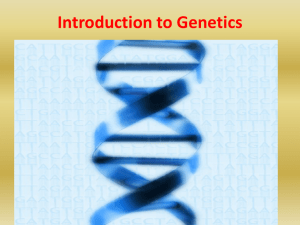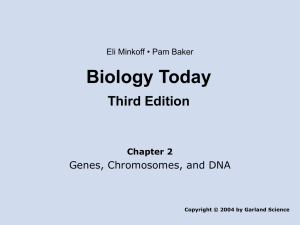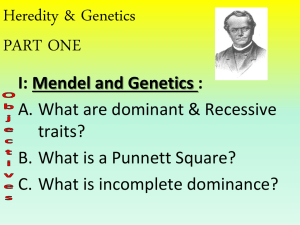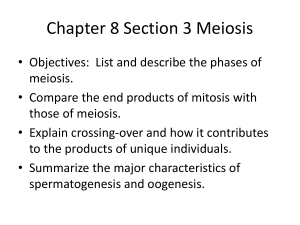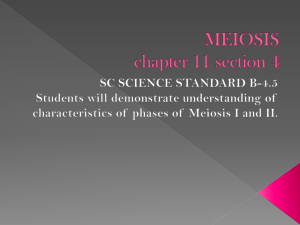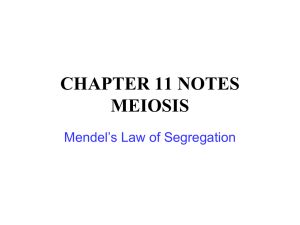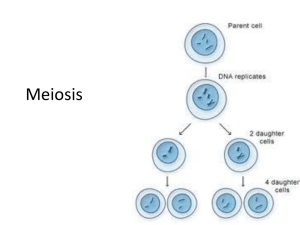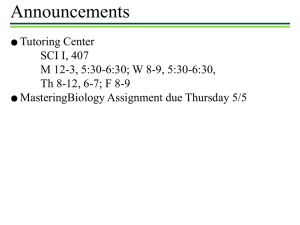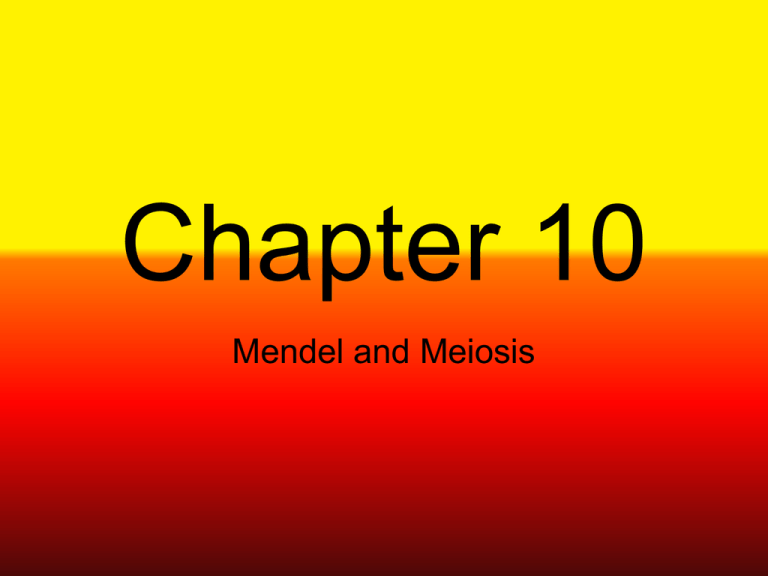
Chapter 10
Mendel and Meiosis
Section 10.1
Mendel’s Laws of Heredity
Why Mendel Succeeded:
• Mendel chose his subjects
carefully
-He chose the garden pea
plant because they
reproduce with sex cells
called gametes.
• Mendel was a careful researcher
-He studied only one trait
at a time to control
variables, and he analyzed his
data mathematically.
Mendel’s Monohybrid Crosses
The First and Second Generations
Mendel he cross pollinated short and tall plants
and in the first generation it appeared as if the
short gene of the plant never existed.
However, in the second generation, he let them
self pollinate, and he found that three-forth’s of the
generation were tall and the other forth was short.
The Rule of Unit Factors and the Rule of Dominance
The rule of unit factors
is a conclusion that each
organism has two factors
that control each of it’s traits.
These factors are genes that
are located on chromosomes
and the genes exist in
alternative forms called
alleles.
When Mendel crossed
the tall plant with the short
plant, the first generation
plants were small which
means only one trait was
observed. He called the
observed trait dominant and
the trait that disappeared
recessive.
The Law of Segregation
When the first generation then reproduced the result was a trait of
shortness. The law of segregation basically states that because each
plant has two different alleles, it can produce two different types of
gametes. During fertilization, male and female gametes randomly pair
to produce four combinations of alleles.
Phenotypes and Genotypes
Two organisms can look alike but
have different underlying allele
combinations. The way and organism
looks and behaves is called its
phenotype. The phenotype of a tall
plant is tall, whether it is TT or Tt.
The allele combination an
organism contains is known as its
genotype. The genotype of a plant that
has two tall genes is TT.
An organism is homozygous for
a trait if its two alleles for the trait are
the same. The breeding tall plant that
had two alleles for tallness would be
homozygous for the trait of height.
Because tallness is dominant for that
trait, a TT individual is homozygous
dominant for that trait.
Mendel’s Dihybrid Crosses
Mendel performed another set of crosses in which
he used peas that differed from each other in two
traits rather than only one. The Law of
Independent assortment is Mendel’s second law
that states for different traits are inherited
independently of each other.
Punnett Squares
Monohybrid Crosses
Dihybrid Crosses
Section 10.2
Meiosis
Diploid and Haploid Cells
A cell with two of each
kind of chromosome is
called a diploid cell.
A cell containing one of
each kind of chromosome is
called a haploid cell.
Homologous Chromosomes
The two chromosomes of each pair in a diploid
cell are called homologous chromosomes. Each
pair of chromosomes has genes for the same
traits, such as plant height.
Why Meiosis?
When cells divide by
mitosis, the new cells have
exactly the same number
and kind of chromosomes
as the original cells. The
kind of cell division, which
produces gametes
containing half the number
of chromosomes as a
parent’s body cell is called
meiosis. Meiosis occurs in
the specialized body cells of
each parent that produce
gametes.
Phase One of Meiosis
During meiosis, a spindle forms and the cytoplasm divides in
the same ways they do during mitosis. However, what happens
to the chromosomes in meiosis is very different.
Phase Two of Meiosis
The second division in meiosis is simply a mitotic division of the products of
meiosis I. The newly formed cells in some organisms undergo a short
resting stage. In other organisms, however, the cells go from late anaphase
of meiosis I directly to metaphase of meiosis II.
Meiosis Provides for Genetic Variation
• Genetic recombination
-Each cell undergoing meiosis has
seven pairs of chromosomes.
Genetic recombination is the
reassortment of chromosomes
and the genetic information they
carry, either by crossing over or
by independent segregation of
homologous chromosomes.
Crossing over is the process when
chromatids pair so tightly that
non-sister chromatids from
homologous chromosomes can
actually break and exchange
genetic material.
• Meiosis explains Mendel’s results
-The segregation of chromosomes
in anaphase I of meioses explains
that each parent gives one allele
for each trait at random to each
offspring.
Nondisjunction
The failure of homologous chromosomes to
separate properly during meiosis is called
nondisjunction. Polyploidy is an organism with
more than the usual number of chromosome sets.
Gene Linkage and Maps
Genes sometimes
appear to be inherited
together instead of
independently. If
genes are close
together on the same
chromosome, they
usually are inherited
together.
Meiosis vs. Mitosis
THE END!
Finally.

